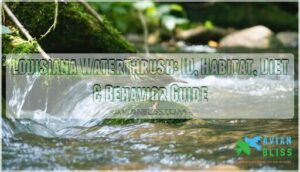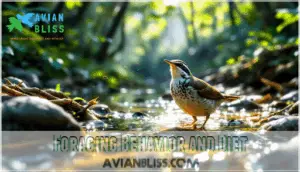This site is supported by our readers. We may earn a commission, at no cost to you, if you purchase through links.

The Louisiana waterthrush isn’t content with typical warbler behavior—no flitting through treetops or hovering at flower blossoms. This bird walks. It stalks stream edges like a shorebird, flipping leaves with its stout bill and snatching aquatic prey from the shallows. Its constant tail-bobbing motion acts as a visual signature, telegraphing its presence to anyone who knows what to watch for.
Understanding this species means understanding the clean, cold streams it depends on—habitats that tell us more about ecosystem health than most laboratory tests ever could.
Table Of Contents
- Key Takeaways
- Louisiana Waterthrush Identification and Features
- Habitat Preferences and Geographic Distribution
- Foraging Behavior and Diet
- Breeding Habits and Nesting Biology
- Conservation Status and Threats
- Frequently Asked Questions (FAQs)
- How to tell the difference between a Louisiana and Northern Waterthrush?
- What are some interesting facts about the Louisiana Waterthrush?
- Where do Louisiana Waterthrush nest?
- What do Louisiana waterthrushes eat?
- How does Louisiana Waterthrush differ from other warbler species?
- What is the role of the Louisiana Waterthrush in its ecosystem?
- How has climate change impacted the Louisiana Waterthrush population?
- What are common threats to the Louisiana Waterthrushs survival?
- How can the public help conservation efforts for the Louisiana Waterthrush?
- What sounds does the Louisiana Waterthrush make?
- Conclusion
Key Takeaways
- The Louisiana Waterthrush serves as a living indicator of stream health—its presence signals clean, fast-flowing water with abundant aquatic invertebrates, making it more reliable than many lab tests for assessing ecosystem quality.
- This warbler breaks typical warbler behavior by walking deliberately along streambeds rather than flitting through trees, using its stout bill to flip leaves and its long legs to wade through shallows while constantly bobbing its tail.
- Breeding success depends entirely on mature riparian forests with pristine streams—habitat loss from logging, pollution from mining and agriculture, and climate-driven water flow changes threaten populations across both breeding and wintering grounds.
- The species arrives earlier than most warblers in spring and demonstrates specialized site fidelity, claiming territories along steep ravines where rocky streambeds, dense canopy cover, and clean water converge.
Louisiana Waterthrush Identification and Features
Spotting a Louisiana Waterthrush in the field isn’t as tricky as you might think once you know what to look for. This warbler has a few standout features that set it apart from similar species, especially its close cousin.
Here’s what you need to watch for to confirm your ID.
Distinguishing Physical Characteristics
You’ll recognize the Louisiana Waterthrush by its sturdy build—this large warbler sports a stout bill, long legs, and a strikingly short tail that sets it apart from its slimmer cousins.
Your field identification gets easier when you note these key waterthrush characteristics:
- Bill shape: stout and heavy, built for flipping leaves and catching aquatic prey
- Leg length: exceptionally long, perfect for wading along rocky streambeds
- Body size: plump and substantial compared to other warblers
- Color pattern: warm brown upperparts with bold white eyebrow stripes
These size and shape features make this bird species identification straightforward once you’ve seen one in action.
Comparison With Northern Waterthrush
When you’re standing at a stream trying to tell these two species apart, the bill becomes your best friend—the Louisiana’s stout, heavy beak clearly outweighs the Northern’s slimmer, more delicate version. But don’t stop there—plumage color separates them too, with the Louisiana showing warmer brown tones and a bright white eyebrow.
| Feature | Louisiana Waterthrush | Northern Waterthrush |
|---|---|---|
| Bill Size | Stout, heavy | Slim, delicate |
| Plumage Color | Warm brown, bright white eyebrow | Olive-brown, yellowish eyebrow |
| Song Patterns | Ringing, descending notes | Rapid, explosive chatter |
| Migration Routes | Earlier spring arrival | Later spring arrival |
| Hybridization Risks | Minimal (habitat separation) | Minimal (habitat separation) |
These waterthrush characteristics make bird species identification achievable—you’ll nail this warbler comparison once you’ve studied both species side by side.
Tail-Bobbing and Behavioral Traits
Once you’ve locked in the ID, watch how this warbler moves—its signature tail-bobbing sets it apart from nearly every other bird along the stream. The Louisiana Waterthrush constantly bends and straightens its legs, creating that rhythmic bounce—a behavioral trait that’s unmistakable whether it’s foraging, defending territory, or traversing rocky streambeds.
- The tail pumps steadily as the bird stalks prey across wet stones, turning this avian behavior into a mesmerizing rhythm
- During territorial defense, the tail-bobbing intensifies while the warbler species patrols its breeding range
- Courtship displays incorporate exaggerated movements, blending foraging strategies with social interactions along fast-flowing waters
Habitat Preferences and Geographic Distribution
You’ll find Louisiana Waterthrushes where clean water meets mature forest—they’re picky about their real estate.
These warblers don’t just show up anywhere; they follow specific patterns across seasons and landscapes.
Let’s break down where they live, where they travel, and what makes a stream worth claiming as territory.
Riparian Forest and Stream Environments
You’ll find Louisiana Waterthrushes in the kind of mature riparian forests that cradle fast-moving streams—places where steep ravines echo with rushing water tumbling over rocky beds and riffles.
These riparian forest corridors aren’t just scenic backdrops—they’re living systems where forest hydrology meets stream ecology. Water quality matters here; healthy ecosystems with abundant riffles and proper river dynamics create the ideal conditions for this bird’s survival, offering both the aquatic invertebrates it hunts and the protective canopy it needs.
Riparian forests are living systems where water quality, stream ecology, and forest structure converge to sustain the Louisiana Waterthrush
Range and Seasonal Movements
Across eastern U.S. forests and beyond, this warbler’s seasonal movements trace one of the most impressive avian migration patterns among wood-warblers—spanning thousands of kilometers between breeding territories and tropical wintering grounds.
Migration patterns reveal striking precision:
- Spring arrival: You’ll witness them from early March through mid-April—among the earliest warblers to reclaim their geographic range each year.
- Breeding season: Peak nesting unfolds from late April to early July across mature habitat corridors stretching up to 4,000 feet along streams.
- Fall departure: Most birds abandon breeding territories by late July, completing their southward journey before September ends.
- Winter range: They scatter across Central America, the Caribbean, Mexico, and northwestern South America—frequenting lowland streams and coastal mangroves.
These seasonal shifts in habitat movement connect disparate ecosystems across hemispheres. Understanding the waterthrush species is essential for appreciating their migration habits.
Key Factors for Habitat Selection
When you’re tracking down Louisiana Waterthrushes in the field, stream characteristics dictate everything—these warblers stake their breeding claims where water quality, forest structure, and substrate composition align just right. Stream quality and water flow over rocky beds matter most—clear, fast-moving currents signal healthy riparian zones.
Terrain slope creates those steep-sided ravines they prefer, while dense forest density overhead shields nesting sites.
For bird identification in avian ecology, matching habitat clues to ornithology field marks sharpens your skills and bolsters habitat conservation.
Foraging Behavior and Diet
Watch a Louisiana Waterthrush hunt for food and you’ll see why these birds are masters of their waterside domain. Their foraging strategy is a mix of patience, precision, and constant motion—whether they’re flipping leaves, wading through shallows, or snatching insects mid-flight.
Here’s how they find their next meal and what’s on the menu throughout the year.
Ground Foraging Techniques
If you watch a Louisiana Waterthrush hunt for food, you’ll notice it doesn’t hop like most warblers—it walks deliberately along stream edges, turning over leaves and probing wet moss with a confident, methodical stride. This ground search strategy sets it apart during bird watching sessions:
- You’ll spot steady leaf turning along water edges
- The bird walks rather than hops—pure focus
- Stream sides become hunting grounds, not just perches
- Each step reveals hidden prey in systematic patterns
This foraging behavior distinguishes it from the Northern Waterthrush’s less purposeful feeding style.
Aquatic and Terrestrial Food Sources
The Louisiana Waterthrush’s menu reads like a riverside buffet—aquatic insects, tiny crustaceans, mollusks, and whatever grubs hide beneath soggy leaves or moss-covered stones. Stream ecology dictates what’s on offer, making wetland foraging a varied experience shaped by water quality and flow.
| Food Type | Examples | Habitat Source |
|---|---|---|
| Aquatic Insects | Mayfly nymphs, caddisfly larvae | Stream riffles, rocky beds |
| Terrestrial Crustaceans | Small amphipods, isopods | Wet leaf litter, moss |
| Mollusks | Tiny snails, freshwater clams | Stream edges, submerged rocks |
| Flying Insects | Midges, gnats, small flies | Air above water surface |
| Grubs & Larvae | Beetle larvae, worm-like invertebrates | Decaying vegetation, wet soil |
This diverse wildlife diet and nutrition strategy keeps food chains healthy in riparian zones.
Seasonal Dietary Variations
As seasons shift, so does the waterthrush’s grocery list—spring floods bring different prey than summer’s low flows, and winter territories down south serve up a completely different spread than breeding season streams up north. Seasonal shifts in food sources drive dietary adaptations you can track through feeding behavior changes:
- Spring breeding: Mayfly nymphs and caddisfly larvae peak in nutrient intake
- Summer abundance: Terrestrial insects supplement aquatic foraging strategies
- Fall migration: High-energy prey fuels long-distance travel
- Winter grounds: Tropical stream invertebrates reshape the bird species diet
- Annual patterns: Avian ecology and behavior respond to wildlife diet and nutrition cycles
Breeding Habits and Nesting Biology
When you’re tracking Louisiana Waterthrushes during breeding season, you’ll notice their nesting habits are as particular as their habitat choices. These birds don’t just build anywhere—they’re selective about where they raise their young, and their breeding success depends on it.
Here’s what you need to know about their nest sites, parenting approach, and reproductive outcomes.
Nest Site Selection and Construction
You’ll find Louisiana Waterthrushes building their nests in spots that most birds wouldn’t dare to touch—tucked into steep banks, hidden beneath tangled roots, or wedged into rocky crevices right above rushing streams. These nesting sites offer natural protection from predators.
The birds weave grasses, leaves, and moss into cup-shaped structures, using construction techniques that anchor the nest firmly against erosion and flooding—critical for breeding success.
Egg Laying and Parental Care
Once the nest is ready, the female lays four to six creamy-white eggs speckled with brown. Then, both parents share the demanding work of incubation and feeding—though the female manages most of the brooding during those critical 12 to 14 days. Parental roles shift once the nestlings hatch:
- Both adults hunt insects and aquatic prey near the stream
- Chick rearing demands constant feeding trips throughout daylight hours
- Parents remove fecal sacs to keep the nest clean
- Adults fiercely defend territory against intruders during brood care
- Young fledge after 9 to 10 days but depend on parents for another two weeks
Egg incubation and nesting require relentless commitment from these devoted bird breeding habits.
Breeding Productivity and Success
Despite this tireless effort from both parents, breeding success in Louisiana Waterthrushes hinges on factors beyond sheer devotion—stream quality, nest predators, and weather patterns all shape whether a pair raises one healthy brood or loses everything. Healthy breeding habitat with clean, fast-flowing streams boosts fledgling rates dramatically. Pair bonding strengthens over successive breeding seasons, improving reproductive output.
| Factor | Impact on Nesting Success |
|---|---|
| Stream pollution | Reduces aquatic prey, lowers survival |
| Raccoon predation | Destroys up to 40% of nests annually |
| Heavy spring rains | Floods nests, forces re-nesting |
| Forest fragmentation | Increases cowbird parasitism risk |
Nesting dates shift earlier in warmer years, affecting breeding and nesting habits.
Conservation Status and Threats
The Louisiana Waterthrush faces real challenges that threaten its survival in the wild. From shrinking forests to polluted streams, this species depends on ecosystems that are increasingly under pressure.
Here’s what you need to know about the threats it faces and the work being done to protect it.
Habitat Loss and Fragmentation
Across breeding and wintering grounds, habitat destruction from logging, urban sprawl, and agriculture threatens Louisiana Waterthrush populations. Forest fragmentation reduces patch size below the 1,000-hectare threshold needed for stable numbers. Shale gas development destroys riparian forests while increasing edge effects and cowbird parasitism.
Ecosystem disruption from deforestation impacts both biodiversity loss and wildlife conservation efforts. The species is an obligate riparian songbird that breeds in the eastern United States.
Habitat conservation efforts targeting avian habitat and the ecological importance of riparian forests remain critical for this stream-obligate species.
Water Quality and Ecosystem Health
Beyond habitat loss, stream pollution strikes at the heart of survival for Louisiana Waterthrush. Water chemistry changes from acid mine drainage, agricultural runoff, and hydraulic fracturing alter aquatic health dramatically.
You’ll find territories abandoned where total dissolved solids spike and mayflies vanish—ecosystem degradation that cuts fledging rates by half.
Environmental monitoring through environmental science reveals this species as a living gauge of ecological balance, responding to ecosystem management decisions with measurable shifts in diet and breeding success. Environmental impact on wildlife becomes quantifiable through ecology studies tracking this sentinel of stream integrity.
Conservation Efforts and Monitoring
Through partnerships spanning borders, Wildlife Conservation and Species Monitoring are rewriting this warbler’s future. Canada’s recovery strategy prioritizes Protected Areas designation, while Ontario’s stewardship programs engage landowners in Habitat Restoration—maintaining 50-meter stream buffers and 70% canopy cover.
Conservation Planning now integrates specialized survey methods, recognizing standard protocols miss this species entirely:
- Geolocator studies tracked migration routes spanning 3,000 miles to Guatemala
- Annual nest searching and prey surveys assess breeding productivity in key regions
- Stream health research refines habitat guidelines through acidification impact studies
- Cross-border Research Initiatives address knowledge gaps in migration ecology
These Environmental Conservation Efforts demonstrate adaptive Species Conservation Strategies, with fewer than 500 Canadian adults depending on habitat quality both north and south.
Frequently Asked Questions (FAQs)
How to tell the difference between a Louisiana and Northern Waterthrush?
If you’ve seen one waterthrush bobbing along a stream, look closer—bill size and leg length tell the story.
Louisiana sports a stouter bill and strikingly longer pink legs compared to Northern’s slimmer profile and yellowish legs.
What are some interesting facts about the Louisiana Waterthrush?
This bird species ranks as the largest wood warbler in ornithology. Bird migration patterns show waterthrushes arrive earlier than most warblers in both spring and fall.
Territorial defense involves two distinct song types during the breeding season.
Where do Louisiana Waterthrush nest?
These birds build hidden nests on breeding grounds along stream banks in riparian zones.
You’ll find their nesting sites tucked into forest floors near fast-flowing waters—steep ravines with rocky beds make ideal breeding territory where habitat selection meets their need for mature riparian forests.
What do Louisiana waterthrushes eat?
Their aquatic diet centers on insect prey—mayfly nymphs, caddisfly larvae, and beetles—plus crustaceans like crayfish.
Feeding behavior involves flipping wet leaves and snatching insects from moss-covered stones, showcasing their specialized foraging habits.
How does Louisiana Waterthrush differ from other warbler species?
Like ghosts in the forest mist, most New World warblers flit through the canopy—but this one breaks the mold. Within Parulidae, Louisiana Waterthrush stands apart through its sturdy bill, unusual leg length, and ground-dwelling habits near streams, contrasting sharply with typical warbler morphology and arboreal behavior patterns across species.
What is the role of the Louisiana Waterthrush in its ecosystem?
You’ll find this warbler acts as an ecosystem engineer, shaping food web dynamics through insect predation.
It maintains ecological balance by controlling aquatic invertebrate populations, supporting biodiversity conservation efforts and highlighting the importance of habitat preservation in avian ecology.
How has climate change impacted the Louisiana Waterthrush population?
Climate Shift drives Habitat Disruption through altered stream flow patterns and drought, reducing aquatic insect populations—critical for this species’ diet and survival.
This threatens Population Trends and Ecosystem Resilience across breeding ranges.
What are common threats to the Louisiana Waterthrushs survival?
Habitat Destruction tears through riparian forests like wildfire through dry brush. Pollution Effects degrade stream quality. Climate Change alters water flow patterns. Human Activity fragments breeding territories.
These environmental impacts on bird populations challenge demand urgent species conservation strategies.
How can the public help conservation efforts for the Louisiana Waterthrush?
You can support wildlife conservation efforts through community engagement and volunteer opportunities.
Join local stream monitoring programs, practice eco-friendly habits that protect water quality, and choose sustainable tourism options that fund biodiversity conservation initiatives.
What sounds does the Louisiana Waterthrush make?
You’ll recognize vocalization patterns before you spot this warbler—its song mimics rushing water. The Louisiana Waterthrush delivers descending high-pitched notes that cascade into a jumble of hurried phrases, loud enough to echo through ornithology resources.
Sharp, metallic chip calls serve as auditory signals, while both sexes give zizz calls during courtship.
Conclusion
Think of the Louisiana waterthrush as a living water quality meter—where it thrives, clean streams flow strong. You’ve learned to spot its tail-bobbing walk, decode its habitat needs, and understand the fragile connection between this species and the riparian corridors it patrols.
Next time you hear rushing water, slow down. Look closer at the stream edges. That brown blur working the shoreline might just be your best field teacher yet.










